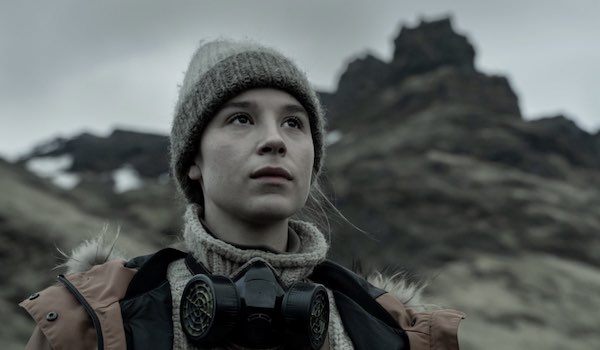Watch Closely: “Katla” — The Horror Beneath and Around Us
By Peg Aloi
A haunting vision of lost souls who emerge from the Icelandic ice, naked, hungry, and seeking communion with those they left behind.
Katla, directed by Baltasar Kormakur. Streaming on Netflix

A scene from Katla.
I was so intrigued by Baltasar Kormakur’s Trapped, an Icelandic crime thriller series, that I went to great lengths to watch it before it was available on streaming services in the US. The director’s latest has finally debuted on Netflix, and it is every bit as compelling and finely crafted as his previous series. Like Trapped, Katla is a rather straightforward, character-driven story of trauma and small town provincialism. But Katla also brings in elements of mystery, folklore, and the supernatural. In the confident hands of this filmmaker, the powerful narrative unfolds with striking simplicity and intensity.
The setting is the tiny remote village of Vik in Iceland, where a recent volcanic eruption of Katla, an active subglacial volcano, has rendered the area somewhat toxic and inhospitable. A ragged band of meteorologists, wilderness rescue workers, and intrepid local farmers carry on. At the beginning of the series, a female figure, covered in mud and ash, emerges from the glacier above the volcano and staggers toward the village. The volcano erupted a year before, and the remaining residents are still reeling: some are grieving for loved ones lost in the eruption, others have not recovered from earlier traumas. This shared pain, intertwined among these characters, underlies a mystery that envelops them all, rooted in a haunted past that many of the villagers have sought to forget.
The mysterious woman is discovered by a team of rescuers, including Grima, whose father Thor (Icelandic actor Ingvar Sigursson, seen in Trapped, Everest, the Justice League films, and many other roles) seems to recognize the strange visitor. The woman says her name is Gunhild and she says she works in the local hotel. It turns out a woman named Gunhild used to work there some 20 years ago. At least that is what we learn from the longtime hotel owner, a rather strange and witchy character herself. She appears unfazed but tantalized by the mystery. While she is healing in the hospital, Gunhild announces she is pregnant with her lover’s child.
One of the show’s initial protagonists is Grima (pop star Gudrun Eyfjord, making her acting debut), whose relationship with her farmer husband Kjartan has become distant because of the disappearance of her sister Asa a year ago and her mother’s recent death. Barely a day after the arrival of Gunhild, another cryptic female figure appears, also naked and covered in mud. She appears to be Asa, Grima’s sister, who disappeared down an icy crevasse while on a rescue mission a year before. She had been presumed dead.

A scene from Katla.
By this point it’s clear strange things are happening. Thor, shocked by the reappearance of his daughter, is also disturbed by the appearance of Gunhild, whom he had a relationship with decades earlier. But it is impossible this could be the “real” Gunhild: the woman is much older and now lives in Sweden. More mud-covered people — who’ve disappeared or gone missing — emerge from the glacier, suffering from shock and exposure. But, like Gunhild and Asa, they know who they are and where they belong, even if the life of the village has continued without them. The phenomenon is so odd and yet so corporeal; even the die-hard scientists are swept up in the phenomenon, as specters from the past continue to stumble into their lives. But, in each case, the emergence of missing people, or their younger selves, triggers a cascade of difficult emotions, reckonings with grief, regret, and anger.
The explanation for these appearances is somewhat ambiguous, part meteorological, part folkloric, but no less fascinating because it is left so unresolved. What would happen if we were suddenly confronted with a lost part of ourselves? Could we make peace with it, or would we turn away in fear? The central premise may sound fantastical, but Kormakur, a masterful storyteller assisted by an adept team of writers, wisely grounds the weird happenings in the intimate details of characters’ lives. The cast, mostly actors based in Iceland, could not be better. Filmed on location in Vik, the production was stymied by pandemic difficulties and delays. The gritty authenticity of the setting is juxtaposed with a grand, ethereal score composed by Högni Egilsson and performed by the Icelandic Symphony orchestra. The music is intricately and exquisitely employed, enhancing and defining the story arc at the end of each episode. It is apt accompaniment for Katla‘s haunting vision of lost souls who emerge from the ice, naked, hungry, and seeking communion with those they left behind.
Peg Aloi is a former film critic for the Boston Phoenix and member of the Boston Society of Film Critics. She taught film studies in Boston for over a decade. She writes on film, TV, and culture for web publications like Vice, Polygon, Bustle, Mic, Orlando Weekly, Crooked Marquee, and Bloody Disgusting. Her blog “The Witching Hour” can be found at themediawitch.com.

You interpreted the series so well.
I am very much caught up in it.
Thanks!
Interestingly the English dubbing was performed by the same cast members, giving it a sense of authenticity and emotion you rarely get from dubbing. I watched it mostly in Icelandic, but sometimes I watched in English when I got tired of reading subtitles. Either way, the series was excellent and the acting superb.